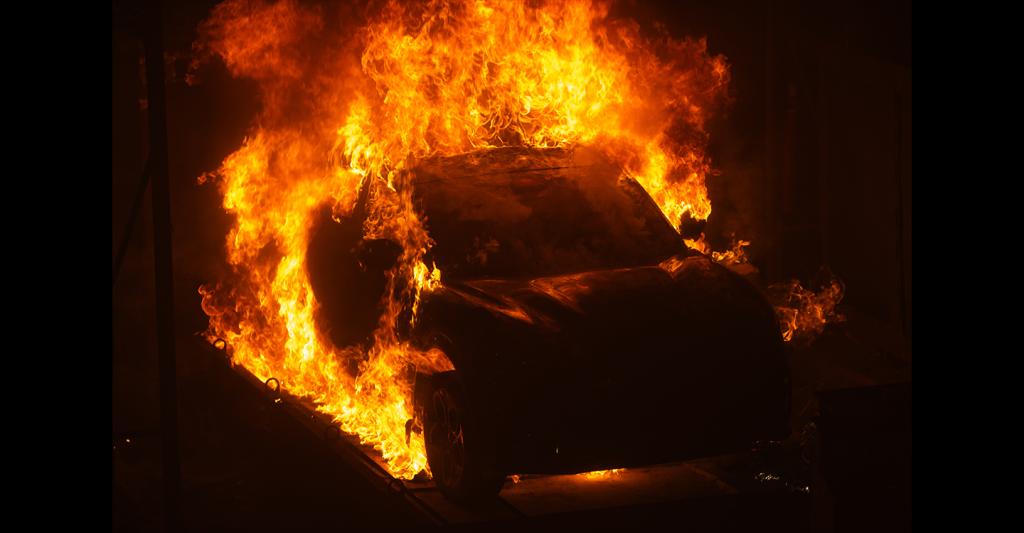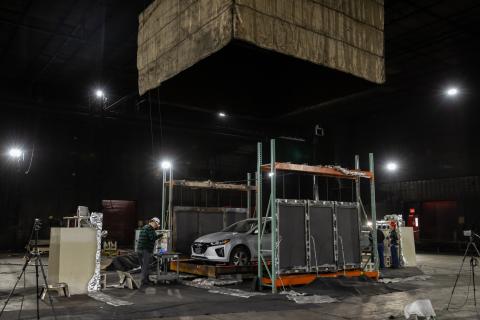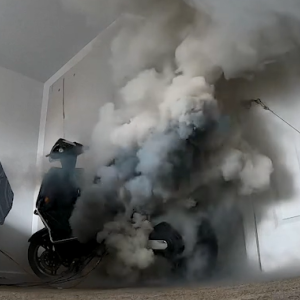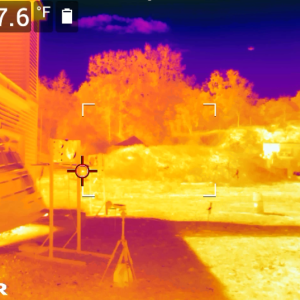
Experiments Enabling Analysis of Electric Vehicle Fire Behavior are Completed
The Fire Safety Research Institute (FSRI), part of UL Research Institutes, completed experiments this winter to study the burning characteristics of electric vehicles (EV). Experiments—the first of two phases in the Fire Safety of Batteries and Electric Vehicles research project—were conducted at UL’s indoor laboratory in Northbrook, IL. The objective of this phase is to obtain full-scale freeburn data without suppression and compare this data with internal combustion engine vehicle (ICEV) fires to identify and understand observed differences with fire behavior and toxic gas exposures.
Among the fire service, there are concerns about EV fire behavior and occupational exposure hazards. There is not yet sufficient data to characterize EV fire dynamics to develop efficient, effective, and safe size-up and fire control strategies. The fire service wants to understand which fire control strategies (i.e. allowing the EV to burn out and consume the battery, to initiate suppression tactics, or modification to existing ICEV approaches) may be most effective at controlling EV fires. Additionally, first responders want to understand occupational thermal and chemical exposure risks to individuals who may be present during an EV fire.
About the EV Fire Behavior Experiments
In this first phase of experiments, a total of six (6) popular EV models were used to understand the differences vehicle construction may have on EV fire behavior. Each test was conducted as a freeburn experiment allowing the vehicle to burn to completion and to simulate an approach of non-intervention with regard to suppression.
During each EV test, a propane burner was used to heat the lithium-ion battery pack and left to operate until thermal runaway was confirmed. Following thermal runaway, the burner was turned off and the vehicles continued to burn uninterrupted while measurements were collected. Once ignited, the vehicles typically burned out within approximately one hour. Data was collected to understand the fire growth rate, peak size, and duration. Measurements also included thermal and chemical exposure hazards to firefighters, and the ignition potential of nearby vehicles or structures.
EV Fire Behavior Measurement Data Collection
Both routine and innovative fire measurement instrumentation was used to collect data related to heat release rate, heat flux, and occupational exposure hazards to combustion products.
- EVs were positioned on top of a metal pan constructed to measure vehicle weight during the freeburn and determine its heat release rate.
- Heat flux gauges were positioned 9–15 feet from the vehicle to measure radiant heat flux.
- Sheet metal panels were placed on each side of the EV with infrared cameras positioned 11 feet from the unexposed sides to enable calculation of incident radiant heat flux to nearby vehicles or structures.
- Two stations containing turnout gear swatches were positioned at 10 and 15 feet from the EVs to collect chemical samples.
- Examination of deposition of contaminants on turnout gear composites and quantification of cleaning effectiveness following exposure to products of combustion were conducted with collaborators at North Carolina State University
- Fourier-transform infrared spectroscopy (FTIR), gas chromatography (GC), sorbent tubes, and solid particulate sample capturing methods were employed to enable measurement of gas, vapor, and particulate emissions in both the fire plume and locations where firefighters might work with partners at the National Institute for Occupational Safety and Health (NIOSH) and Duke University.
- Novel techniques were utilized for particulate chemistry and toxicity analysis of combustion products with partners at NIOSH and the U.S. Environmental Protection Agency (EPA).

Next Steps and Planning for Phase Two Experiments
Following completion of the EV fire behavior experiments, the research team will conduct data analysis with input from the research project’s technical panel. Following data analysis, a technical report will be published later this year, and a series of suppression strategies will be selected for testing in the second phase of experiments next year.
“As we analyze the data to understand how EVs burn, we will work with the understanding that approximately 34,000 fire departments in North America need better information on EV fire control, and our colleagues overseas are working with the same urgency. It is imperative we improve the understanding of how EVs burn compared to the ICEVs we know, what risks they present to people, first responders and the built environment. Our recommendations must consider whether existing firefighting tools can be used to achieve fire control, as the resources of first responders must be considered with utmost responsibility.”
—Adam Barowy, lead research engineer, FSRI

